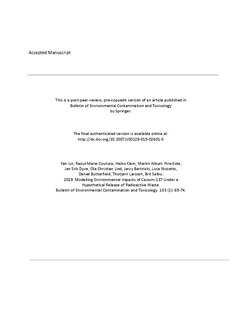| dc.contributor.author | Lin, Yan | |
| dc.contributor.author | Couture, Raoul-Marie | |
| dc.contributor.author | Klein, Heiko | |
| dc.contributor.author | Ytre-Eide, Martin | |
| dc.contributor.author | Dyve, Jan Erik | |
| dc.contributor.author | Lind, Ole Christian | |
| dc.contributor.author | Bartnicki, Jerzy | |
| dc.contributor.author | Nizzetto, Luca | |
| dc.contributor.author | Butterfield, Daniel | |
| dc.contributor.author | Larssen, Thorjørn | |
| dc.contributor.author | Salbu, Brit | |
| dc.date.accessioned | 2019-12-03T09:20:11Z | |
| dc.date.available | 2019-12-03T09:20:11Z | |
| dc.date.created | 2019-09-06T19:00:23Z | |
| dc.date.issued | 2019 | |
| dc.identifier.citation | Bulletin of Environmental Contamination and Toxicology. 2019, 103 (1), 69-74. | nb_NO |
| dc.identifier.issn | 0007-4861 | |
| dc.identifier.uri | http://hdl.handle.net/11250/2631397 | |
| dc.description.abstract | Waste tanks at the nuclear facility located at Sellafield, UK, represent a nuclear source which could release radionuclides to the atmosphere. A model chain which combines atmospheric transport, deposition as well as riverine transport to sea has been developed to predict the riverine activity concentrations of 137Cs. The source term was estimated to be 9 × 104 TBq of 137Cs, or 1% of the assumed total 137Cs inventory of the HAL (Highly Active Liquid) storage tanks. Air dispersion modelling predicted 137Cs deposition reaching 127 kBq m−2 at the Vikedal catchment in Western Norway. Thus, the riverine transport model predicted that the activity concentration of 137Cs in water at the river outlet could reach 9000 Bq m−3 in the aqueous phase and 1000 Bq kg−1 in solid phase at peak level. The lake and river reaches showed different transport patterns due to the buffering effects caused by dilution and slowing down of water velocity. | |
| dc.language.iso | eng | nb_NO |
| dc.title | Modelling environmental impacts of Cesium-137 under a hypothetical release of radioactive waste | nb_NO |
| dc.type | Journal article | nb_NO |
| dc.type | Peer reviewed | nb_NO |
| dc.description.version | acceptedVersion | |
| dc.source.pagenumber | 69-74 | nb_NO |
| dc.source.volume | 103 | nb_NO |
| dc.source.journal | Bulletin of Environmental Contamination and Toxicology | nb_NO |
| dc.source.issue | 1 | nb_NO |
| dc.identifier.doi | 10.1007/s00128-019-02601-5 | |
| dc.identifier.cristin | 1722458 | |
| dc.relation.project | Norges forskningsråd: 291797 | nb_NO |
| cristin.unitcode | 192,0,0,0 | |
| cristin.unitcode | 192,14,0,0 | |
| cristin.unitname | Norges miljø- og biovitenskapelige universitet | |
| cristin.unitname | Miljøvitenskap og naturforvaltning | |
| cristin.ispublished | true | |
| cristin.fulltext | postprint | |
| cristin.qualitycode | 1 | |
